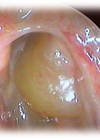Is it time for a change in the way we follow up head and neck cancer patients after treatment? Paul Nankivell and Hisham Mehanna explain the rationale for the PETNECK2 trial.
After completion of curative intent treatment, clinical follow-up currently forms an essential cornerstone of the ongoing management for head and neck cancer (HNC) patients. The purpose of follow-up is multifaceted but includes the assessment of ongoing treatment morbidity and functional deficit, the early detection of recurrent disease or second primary tumours, and the education of patients and caregivers, including support with risk factor modification.
Current UK HNC guidelines align closely with those from other international societies in recommending that patients undergo clinical follow-up every two months for the first two years after treatment, and then every three-to-six months for the next three years. This schedule is predicated on the fact that the risk of recurrence reduces over time, being highest in the first two years after completing treatment. Yet, despite the accepted importance of follow-up, the current system has significant limitations.
1) Is regular-scheduled follow-up the most effective or efficient way of detecting recurrence?
While being the international standard, current strategies for HNC surveillance lack a robust evidence base. Early detection of recurrences offers the best possibility of treatment with curative intent, especially via salvage surgery. Yet regular clinical follow-up does not always achieve this aim, with >60% patients presenting with advanced stage disease [1]. These strategies are also inefficient, with the rate of recurrence detection in asymptomatic patients being low. One study of 1039 consultations identified a suspicion of recurrence in only 0.3% of asymptomatic patients seen routinely. Yet, in those patients requesting an appointment to report a new symptom, the rate of suspicion of recurrence rose to 58% [2]. This finding was replicated in a recent INTEGRATE national audit in the UK [3].
2) Patients are calling for better methods of cancer recurrence detection.
Patients themselves are calling for more flexible, patient-centred follow-up. One of the top research priorities identified in a recent priority-setting exercise undertaken by the National Cancer Research Institute was: ‘What is the optimal follow-up approach to detect whether a cancer has come back?’
3) There are few data on alternative strategies of cancer follow-up.
Adjuvant technologies such as blood or saliva-based biomarkers, in the form of circulating fragments of DNA (ctDNA), have developed rapidly but are not yet ready for widespread clinical use. These liquid biopsies offer the prospect of serial monitoring, with early studies demonstrating HPV ctDNA may be able to help predict and detect recurrent disease. Prospective trial data will be required though before they are incorporated into surveillance strategies.
4) The effect of follow-up on fear of cancer recurrence.
On completion of treatment, many patients experience concern that their cancer may return or progress, which is termed ‘fear of cancer recurrence’ (FCR). This has a major impact on patients’ overall quality of life, and it is well documented in HNC patients. The few qualitative studies examining the effect of follow-up on FCR demonstrate conflicting results – some patients exhibiting lower FCR scores when routinely followed-up, while others having increased anxieties around the time of follow-up appointments which may be further worsened by a reluctance of patients to discuss these feelings with HNC clinicians. Therefore, there remains controversy regarding the effect of routine versus patient-driven surveillance on FCR.
5) Changing epidemiology of HNC
The dramatic and exponential rise in the incidence of HPV-associated oropharyngeal cancer is well documented. Importantly, the significantly better prognosis of this cohort compared to non-HPV associated HNC has led to a rapidly enlarging cohort of HNC survivors, in turn placing significant pressure on clinical services.
The emergence of patient-initiated follow-up (PIFU)
Limited evidence for the effectiveness of routine follow-up schedules, increasing pressure on head and neck cancer services, and patient desires for a more flexible system have led to an interest in exploring alternative follow-up strategies. Patient initiated follow-up (PIFU), is not a new concept, having found more traction to date in non-cancer care, but has recently gained new interest and impetus because of the recognition by government and healthcare leaders that the rising demand on outpatient appointments cannot be met by the current systems. Indeed, in the UK the NHS has a target to reduce outpatient appointments by a quarter in 2024 compared to 2019/2020 levels. PIFU has been identified as a potential tool by which to achieve this reduction, as well as pivoting to a more patient-centred model of care. This model gives patients more control over when and where their care is delivered, and has been demonstrated to improve satisfaction and quality of life, without deleterious effects on outcomes.
This approach may be particularly effective when used in conjunction with stratification based on an individual’s risk of recurrence (e.g. via imaging with PET-CT or associated clinical/pathological factors). A retrospective study examining different intensity of follow-up, stratified by the patient’s risk of recurrence based on PET-CT imaging, found time-to-recurrence detection, overall survival, and proportion of salvageable recurrences was similar between the two cohorts. PET-CT stratified follow up reduced the mean number of visits and led to a significant cost saving [4]. Although these strategies have not yet been widely evaluated in head and neck cancer, clinicians appear willing to engage and test this hypothesis [5].
Assessing PIFU in HNC – the PETNECK2 trial
The PETNECK trial demonstrated that the high negative predictive value of PET-CT imaging three months post chemoradiotherapy was effective at selecting the >80% of patients that could safely avoid a routine neck dissection. Evidence from smaller cohort studies suggests PET-CT retains a high negative predictive ability beyond this initial post treatment period.

Led again by the team at the Institute of Head and Neck Studies and Education in Birmingham, PETNECK2 tests the efficacy and cost-effectiveness of a complex intervention at one year post treatment, against the current standard of care (routine scheduled follow-up). Patients in the intervention arm undergo a PET-CT-scan which, if negative, identifies those patients at low risk of recurrence. These patients then receive a face-to-face information and support education session (co-designed by patients who have undergone HNC treatment), exploring any potential barriers to initiating follow-up that patients may have, and educating and empowering patients by giving them information on how to monitor their symptoms and understand which ‘red flag’ symptoms could indicate a recurrence.
This is reinforced with a specially co-developed information and support resource (available in both written and electronic formats), which also includes available resources on the management of the side effects of treatment, and peer-to-peer services that offer support during the care pathway. After this, patients do not have further follow-up appointments scheduled, but are then on a PIFU pathway – with the guarantee of an open urgent follow-up appointment (within two weeks), if they develop or have a change in symptoms, or feel the need to be seen.
The trial is currently recruiting in HNC centres in the UK and will provide key high-quality evidence to underpin a potential paradigm shift in the follow-up standards for HNC patients.
References
1. Chang JH, Wu CC, Yuan KSP, et al. Locoregionally recurrent head and neck squamous cell carcinoma: incidence, survival, prognostic factors, and treatment outcomes. Oncotarget 2017;8(33):55600–12.
2. Kothari P, Trinidade A, Hewitt RJD, et al. The follow-up of patients with head and neck cancer: an analysis of 1,039 patients. Eur Arch Oto-Rhino-Laryngol 2011;268(8):1191–200.
3. Post‐Treatment Head and Neck Cancer Care: National Audit and Analysis of Current Practice in the United Kingdom. Clin Otolaryngol 2021;46(1):284–94.
4. Shah K, Marvelde LT, Collins M, et al. Safety and cost analysis of an (18)FDG-PET-CT response based follow-up strategy for head and neck cancers treated with primary radiation or chemoradiation. Oral Oncol 2015;51(5):529–35.
5. Lorenc A, Wells M, Fulton-Lieuw T, et al. Clinicians’ Views of Patient-initiated Follow-up in Head and Neck Cancer: a Qualitative Study to Inform the PETNECK2 Trial. Clin. Oncol. (R. Coll. Radiol. (Gt. Br.)) 2021;34(4):230–40.
Declaration of competing interests: PN is Co-Chief investigator for the NIHR funded PETNECK2 trial.










